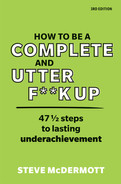Step
29
Don’t go to the movies
Here is a bizarre and little-known fact. Your brain and body can’t tell the difference between something you vividly imagine and reality. Truly. Almost all world-class sportsmen and women are visualisers. As are other peak performers in just about any other field you care to mention. All these people see it, they feel it, and they experience it, before they actually do it. As a formula this would be: I x V = R ((Imagination x Vividness = Reality). The secret is the symbol in the middle, repetition. Repetition – that’s repetition – it would seem really is the mother of all skills.

Of course, apart from positive visualisation, there is another name for this. It’s called worry. What failures do is vividly imagine things going terribly wrong in full Technicolor with quadraphonic sound, over and over and over again. They don’t understand that fear is that little darkroom where negatives are developed. The point is, in life you always get what you focus on. So don’t be aware that it is actually entirely up to you whether you use this special gift to generate good or bad results. Now maybe you are thinking, surely what I think about can’t allow me to do something I’ve never done before or create physical results. Well, yes it can. You see, by constant repetition you coat the neural pathways in the brain. This effectively creates fake but totally believable memories. Specialists in brain research give the following explanation: “When you learn anything, a pattern of neurons is set up in your brain tissue. The chain, or electrical pattern, is your brain’s method of remembering, so since the subconscious cannot distinguish a real from an imagined experience, perfect mental practice can create new patterns or correct imperfect patterns grooved here.”
Visualisation has a definite effect on the body’s electroencephalographic waves. (EEG waves are a measure of electrical activity in the brain.) If you imagine yourself running, small but measurable contractions actually occur in the muscles of your body.
Now it may sound like a couch potato’s dream, but research has proven you can even think yourself strong with imaginary exercises. Researchers asked ten volunteers aged 20 to 35 to imagine flexing one of their biceps as hard as possible in training sessions five times a week. The researchers, whose findings were reported in the magazine New Scientist, recorded the electrical brain activity during the sessions. To make sure volunteers were not unintentionally tensing and moving their arms, they also monitored electrical impulses of their arm muscles. Every two weeks muscle strength was measured. The volunteers who thought about exercise showed a 13.5% increase and maintained that gain for three months after the training stopped. Or how about this – psychologists have developed a mental training system that improved the golf-putting skills of volunteers by more than 50% after only six weeks. The player must practise in his head for ten minutes a day while watching a video of himself playing, or while listening to an audio tape of his putts being holed. He can stand in his living room holding a club, or simply recreate the movements in his head while sitting. Men who used the video method improved by 57%. Those who listened to a tape improved by 47%. One group improved by 18% after simply reading a biography of Jack Nicklaus1 for ten minutes a day. Dr Smith of University of Chester and Professor Paul Holmes of Manchester Metropolitan University are responsible for the study. Says Dr Smith: “Nicklaus always said he imagined where the shot would go – and then it would go there.” Dr Holmes says: “The technique works by strengthening the mental pathways involved in making a putt. It’s like walking through a cornfield. There is a faint pathway the first time you do it, but the more you tread along the same path, the stronger it gets.”
One of the greatest exponents of running mind movies, who coincidentally was known as The Greatest, was Muhammad Ali, the former World Heavyweight Boxing champion. Ali called it “future history”. Ali said: “The man with no imagination has no wings.” He always rehearsed the fight in his head, over and over, before he ever stepped into the ring. That’s one of the reasons why out of the 19 fights in which he predicted the outcome (when he’d say things like “Archie Moore, you’re going in round four”), 17 happened exactly the way Ali said they would – with Ali winning. What people say is, if this technique is so powerful, what about the fights that Ali lost? His answer was that his opponents had just created a stronger future history than him. But I ask you, with only 17 out of 19 correct predictions, is it really worth bothering with even a few minutes of mental rehearsal? Even though five times Olympic gold medallist Sir Steve Redgrave personally told me: “Steve, I probably spent more time training in my head than I ever did sat in a boat!” Doh! What does he know about success?
By the way, if you think all you have to do is imagine success and it’s then served up on a plate, I’ve got news for you. For Ali also said: “The fight is won or lost far away from witnesses. It is won behind the lines, in the gym and out there on the road, long before I dance under those lights.” Ali was talking about the accumulative effect of training in your head and your body. He thought that to be in the real top flight you had to do hours and hours of hard physical work, as well as disciplined mental rehearsal. Oh dear!
1 Remember back at step 11 I suggested you don’t read lots of biographies because it’s bound to improve you. Now it seems that even includes your golf game.
